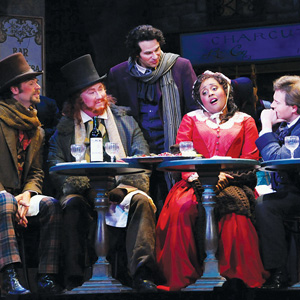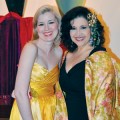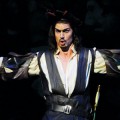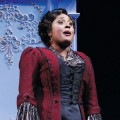Giacomo Puccini knew from personal experience the hardships, nigh unto poverty, suffered by the characters in his popular opera. Yet what he conceals, albeit shrewdly, even cynically, is that the male characters—the poet Rodolfo and the artist Marcello—chose to live the bohemian life, while the female characters—Mimi the seamstress and Musetta the convenient whore—had little if any such option.
Opera San Jose’s Larry Hancock makes the allusion in his program essay when he describes Puccini’s “peek at the scapigliatura“—the “disheveled”—portrayed in Henri Murger’s memoir Scenes de la vie de boheme (Scenes of Bohemian Life). Bohemianism in 19th-century cities like Paris, Milan and New York invited the sons of the bourgeoisie to sow their wild oats before returning to the security, and opportunities, of the privileged life they knew as boys.
In the opera, now running at the California Theatre, the tragedy of Mimi’s doom—of hope and love against loneliness and certain death—momentarily interrupts the carefree antics of the men in their youthful self-indulgence. The performance Sunday afternoon further underscored the divide. A failure to establish Mimi’s professed love for Rodolfo in Act 1 left the final scene of her death in Act 4 hollow and unconvincing.
Given the company’s long string of theatrical successes, and the recent and past history of the two principal actors, Christopher Bengochea and Jouvanca Jean-Baptiste (the roles are double cast), this came as both a surprise and a disappointment. Act I famously warms from a freezing Christmas Eve in a Parisian garret into the full blossom of young love. But here, the act ended as cold as it began, with negative chemistry between the lovers.
Opera San Jose’s mission has always been to teach professional singers how to become actors. Therefore, blame the director, Timothy Near, who evidently assumed her subjects were equally experienced in both disciplines. But acting, someone once observed, is equally reacting. And that means body language, facial expressions, thoughtful hesitations and the rest of a full range of nonverbalized emotions. Bengochea tried valiantly if self-consciously to create the magic while Jean-Baptiste was like a deer in the headlights, in spite of quality singing from both. Chugging along in the pit, conductor David Rohrbaugh was of little help.
Possessed of one of those big plushy sopranos, Jean-Baptiste’s is a voice one could listen to all day. Out of context, her “Mi chiamano Mimi” in Act 1 established a defining vocal presence that would linger in the mind even after the stumbling drama faded.
The much slimmed-down Bengochea reprised his memorable tenor in previous Opera San Jose roles, yet with more evident effort and, at times, forcing the voice. Both Krassen Karagiozov, as Marcello, and Jillian Boye, Musetta, were consistently secure in their roles and vocal production. Boye’s edgy soprano was an ideal fit with her shrewish character. Silas Elash as Colline come through handsomely in the last-act soliloquy to his beloved long coat and otherwise set a standard for the comedic bits. Daniel Cilli gave a rather brittle account of Schaunard.
The riotous Act 2 street scene in front of the Cafe Momus featured the full chorus and children’s chorus all lit up in brightly colored costumes and smartly choreographed by Amanda Folena. (Lee Steward gave the toy-seller Parpignol a joyous portrayal.) Kim Tolman’s set, like that for the Act 3 city gate/inn scene and the garret of Acts 1 and 4, were recycled from the company’s 2006 production. For its broad strokes, Near’s direction kept things well in motion.
The orchestra sounded in great shape, though it and Puccini needed more attention to phrasing and drama than came from Rohrbaugh. The conductor James Levine once described Puccini as a magician. This performance came up wanting in the magic department.
La boheme
Opera San Jose
April 28, 30 and May 3 and 6, 8pm; May 1 and 8, 3pm
California Theatre, San Jose
$51-$101

 Zion I and the Grouch
Zion I and the Grouch 


